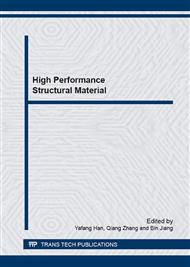p.54
p.64
p.71
p.78
p.84
p.91
p.96
p.102
p.107
Effect of BN Interphase Coating and PIP Cycles on the Mechanical Properties of VSI SiC/SiC Composites
Abstract:
2.5D SiC/SiC composites with and without BN interphase coating were fabricated by VSI process from SiC/C preforms that were produced after 3, 4 and 5 PIP C cycles, respectively. The effect of the BN interphase coating and PIP C cycles on the mechanical properties and microstructure of the composites was investigated. The results indicated that the composites with or without BN interphase coating exhibited catastrophic fracture behavior. Both the excess residual carbon and BN interphase coating played a positive role in protecting the SiC fibers from silication by vapor silicon, which accounted for the less obvious fibers pull-out phenomenon that occurred in the composites. The PIP cycles had an influence on the residual porosity and the content of the newly developed SiC in the composites, and therefore the mechanical properties of the composites were influenced. The composites fabricated from preforms after 4 PIP C cycles and containing BN interphase coating have a flexural strength of 122.5 MPa and a modulus of 86.5 GPa.
Info:
Periodical:
Pages:
84-90
Citation:
Online since:
April 2015
Authors:
Keywords:
Price:
Сopyright:
© 2015 Trans Tech Publications Ltd. All Rights Reserved
Share:
Citation:


